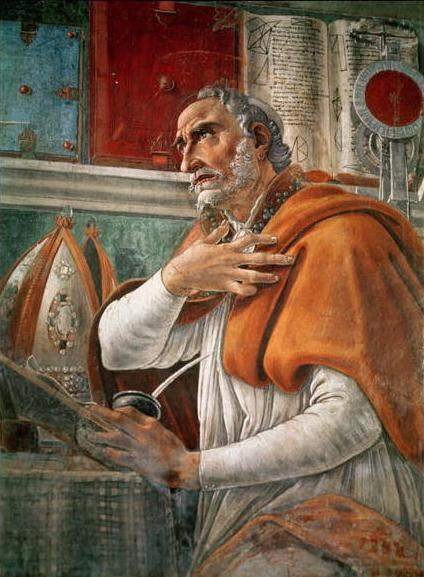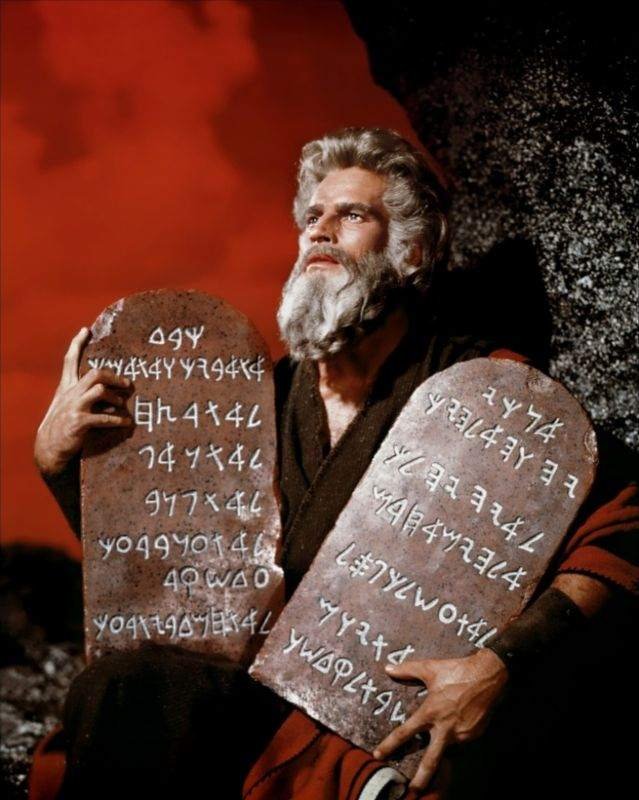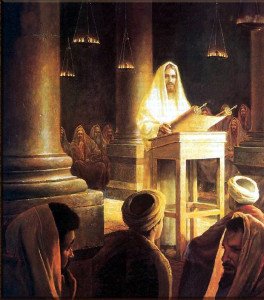
Saint Augustine in His Study (1480), by Botticelli (Wikipedia).
Here’s a little something that I shouldn’t spend a lot of time on by way of introduction (I’m presently nearly at the honest-to-goodness final attack of my thesis) — but it is nonetheless an important apologetic topic: Did Catholics change the Ten Commandments? The presentation of the Ten Commandments (or Decalogue) used by Catholics is in fact different from the one used by many Protestants. The “Catholic Ten Commandments” seems, very suspiciously, to omit the commandment that forbids the making of “graven images” — which, to the minds of anti-Catholics, seems to confirm their every accusation: “Catholics worship idols, and not only do they know it, but they changed the Ten Commandments so their gullible followers would never even know it was wrong!”
… No. The Catholic Church condemns idolatry explicitly, both the worship of images and the exaltation of any thing above God. Why, then, did Catholics “leave out” that commandment? Here are several things the critic should realize:
-
The Ten Commandments are not numbered in Scripture. The original texts of the Bible did not even have verse numbers — the system of verse numbers we have today is a product of the Protestant printer Stephanus.
-
The listings of the Ten Commandments in Exodus 20 and Deuteronomy 5 do not even state that there are ten of them; it is only elsewhere (cf. Exodus 34:28) that they are called the Ten Commandments. Taken by themselves, there are actually about fourteen imperative commands given by the Lord to Moses on Mount Sinai.

St. Augustine was really Moses? Or Charlton Heston was really St. Augustine?
-
When the Church Fathers received this unnumbered, undivided lump of fourteen-ish commandments, it was up to them to formulate them into a list of “Ten,” grouping some commands with others to which they seemed to be related. And different Fathers arrived at different lists.
-
The Catholic Church follows the tradition of numbering established by St. Augustine — and has been since long before anybody numbered the verses. The Lutheran churches follow the same tradition. The Reformed, I suspect just to be contrary and anti-Catholic, were the ones who “changed” the Ten Commandments, adopting the numbering established by Eastern Christianity.
-
Rather than dividing “You shall have no other gods before me” and “You shall not make for yourself any graven image” into two separate commandments, as do the Reformed and Evangelicals, Augustine saw that “making for oneself an idol and bowing before it” (Exodus 20:4) was but an elaboration of having other gods before God, and grouped the two into one commandment. In Catholic catechetical formulae, the “graven images” part is often omitted — not because we are abridging Scripture, but because it is easier for kids to memorize that way, and the part about “graven images” is pretty much redundant. Augustine instead divided “You shall not covet your neighbor’s house” and “You shall not covet your neighbor’s wife” into two commandments.

-
Evangelical Protestants (at least, speaking from my experience) tend to overlook any further grouping of the Ten, and take for granted that five would be placed on either tablet. But Augustine rightly saw an internal division: the first three commandments pertain to man’s obligations to God, and the last seven pertain to man’s obligations to his fellow man. The three pertaining to God, fittingly, form a Trinity.
-
It is worth noting that the commandment against “making a graven image and bowing to it” is not a prohibition against making any image or statue ever. God directly commands the Israelites to fashion images or statues on at least several occasions: the cherubim on the mercy seat of the Ark of the Covenant (Exodus 25:17–22, 37:7–9) and woven into the fabric of the tabernacle (Exodus 26:1, 31, 36:8, 35), the bronze serpent in the desert (Numbers 21:4–9), and the elaborate carvings and adornments of Solomon’s Temple (1 Kings 6–7). This commandment is specifically against idolatry, creating and worshipping images as gods. It is also worth noting that Catholics don’t worship statues.

St. Augustine (c. 1645-1650), Philippe de Champaigne.
When I read in the Catechism about Augustine’s numbering of the Decalogue, I thought that would be a valuable text to have for refuting anti-Catholic arguments, and I set out to find it. I mostly found only other people similarly looking for it, but did find a reference: Question 71 in Augustine’s Questions in Exodus (Quaestio LXXI, Quaestiones in Exodum). At last I found the Latin text, with no English translation — and thought I would do everyone else a service and here give a translation. I am not an expert on this stuff, so if anyone out there is, please feel free to critique my work and help improve it.
Below is St. Augustine’s reasoning regarding why he chose to divide the Decalogue the way that he did, the way that the Catholic Church continues to observe. There was a bit more to the question following this about divisions between the other commandments, the ones regarding which everyone tends to agree — but this was the part relevant to the commandment against idolatry, and the common anti-Catholic charge.
(If anybody is interested in the rest of it, let me know and I can finish the translation. Also, I did this translation months ago! It is not distracting me from my thesis right now other than this introduction I’m giving — which, as usual, has proven more formidable than I intended.)
St. Augustine on How the Ten Commandments are to Be Divided
Quaestiones in Exodum, Question 71
It is asked, in what way the Ten Commandments of the Law are to be divided: whether there are four up to the commandment concerning the Sabbath, which pertain to God Himself, and six that remain, of which the first is, “Honor thy father and mother,”1 which pertain to man; or whether it is more fitting that the former be three, and the latter seven. Indeed those who say the former to be four, separate the commandment, “You shall have have no other gods before me,” that it might be a separate commandment, “You shall not make for yourself an idol,”2 whereby the worshipping of images is prohibited. However those same wish to combine into one, “You shall not covet your neighbor’s wife; you shall not covet your neighbor’s house,”3 and all the rest up to the end. Certainly those who say the first group to be three, and the second group seven, wish to combine into one whatever is commanded concerning worshipping God, that nothing before God is worshipped. These on the other hand divide the last one into two, that “You shall not covet your neighbor’s house” might be a separate commandment. In neither case is there any doubt that there are Ten Commandments, since Scripture itself testifies to this.
Still it seems to me more fitting that the first group be accepted as three, and the other as seven, because those three which pertain to God seem to make known the Trinity to those diligently contemplating. And truly the commandment, “You shall have no other gods before me,” is itself explicated more completely by the prohibition of worshipping images that follows. Further on, coveting another’s wife, and coveting another’s house, differ as much in the sins as in the commandments themselves. “You shall not covet your neighbor’s house” might also be joined to other things Scripture says, “Nor his field, nor his manservant, nor his maidservant, nor his ox, nor his ass, nor anything of your neighbor’s.”4 Moreover coveting the wife of another seems to be separate from coveting anything else of another, since both begin thus, “You shall not covet your neighbor’s wife; You shall not covet your neighbor’s house”: both commandments begin with the statement “You shall not covet,” but it is only to the latter that it fastens the other things, saying nor his house, nor his field, nor his servant, and the rest. These all appear to have been joined together and seem to be contained by one commandment, and are separate from that commandment where the wife has been named. The commandment which says, “You shall have no other gods before me,” appears more devoted to the carrying out of those things which have been placed under it. To what indeed does this pertain, “You shall not make an idol, nor any likeness of anything which is in heaven on high, or anything on earth below, or anything in the sea beneath the earth; you shall not worship them or serve them,”5 unless to the commandment, “You shall have no other gods before me”?





